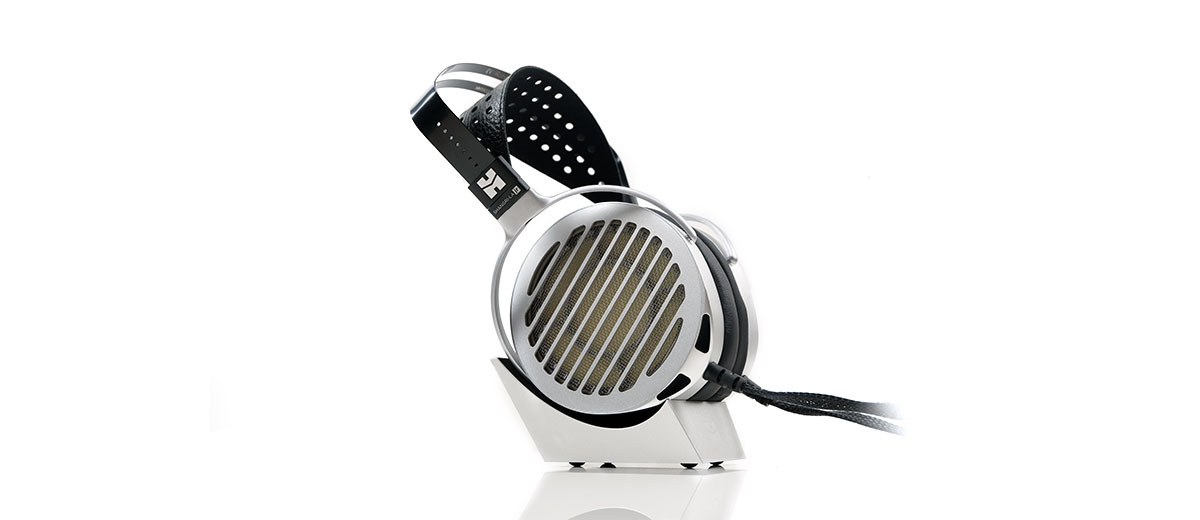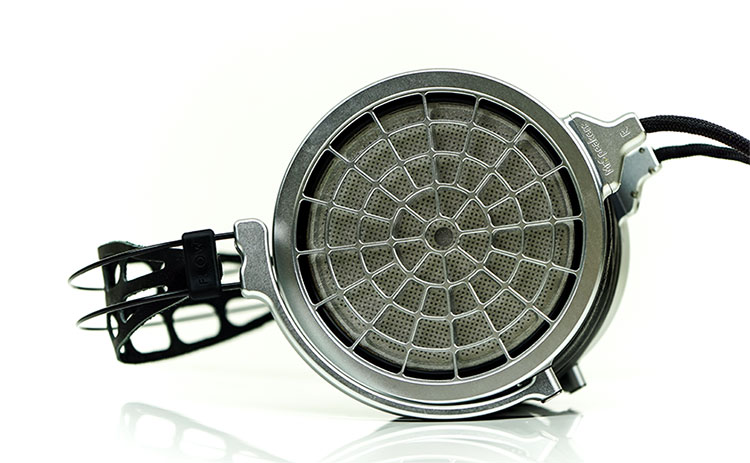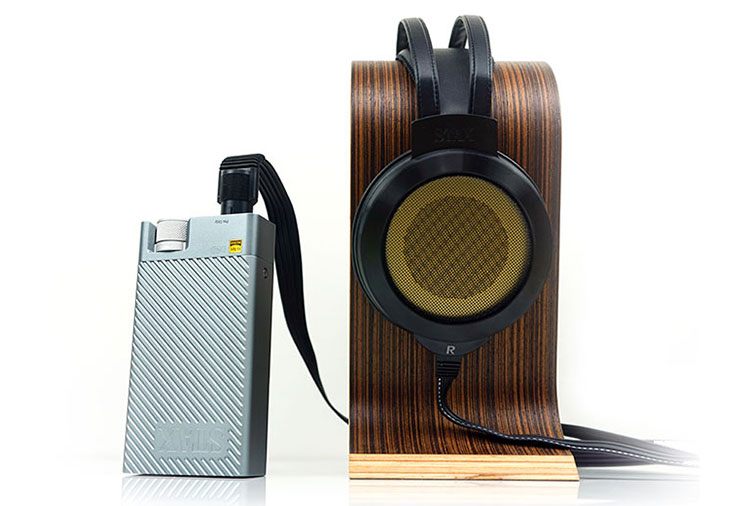Select Comparisons
All comparisons were completed in balanced mode using the Shangri-La Jr main amplifier and a Holo Audio Spring DAC 2 “Wildism Editon” for decoding.
Dan Clark Audio VOCE
The VOCE was reviewed in 2018 and earned a Top Gear Award for open headphones at the end of the year. It is priced a little lower than the Shangri-La Jr but very much an applicable comparison.
$2999
Technical
Both headphones are circumaural electrostatic headphones with the VOCE using an 88mm diaphragm. Though HIFIMAN does not state the precise size of the Shangri-La Jr driver, physically they seem to be of a similar size and rounded shape when placed side by side.
Both companies have tried to deliver super-thin diaphragms to maximize the push-pull response between their respective electrostatic headphone stator grids. The VOCE diaphragm thickness is 2.4 microns or 0.0024mm whereas the Shangri-La Jr is thinner still at just 0.001m in diameter.
Both make a play on their stator grids with the Shangri-La Jr stators also being pitched as being ultra-thin at 0.050mm. DCA has not released their precise VOCE stator dimensions, but they also pitch them as ‘advanced’ and ultra-thin.
Both are pro-bias terminated electrostatic headphones for they can work with a wide range of 580V pro-bias compatible energizers including Stax and Hifiman’s own hybrid Shangri-La Jr amplifier.
Design
The form factors are quite similar with rounded cups instead of elongated and the weight of both are very close at 370g for the VOCE and 374g for the Shangri-La Jr. However, the aesthetic or design flow is very much Hifiman versus Dan Clark Audio with both using company signature features.
That includes the ultra-lightweight Nitinol and leather strap with the half gimbal arch on the VOCE and the classic arching headband, leather strap and heavily articulating pivot block on the Shangri-La Jr.
In terms of engineering, you could argue the VOCE is the more complex looking of the two with that intricate spider web front grill as opposed to the single molded cup and grill window shade design on the Jr. The finishing on the VOCE also has a silvery shimmer as opposed to the matte anodized aluminum aesthetic of the Shangri-La Jr.
Both are equally as comfy as each other with similar pressure distribution and clamping as well as almost identical weight measurements. The main difference here is the selection of pads. The VOCE uses a high-grade thick wedged lambskin compared to the synthetics of slimmer HarmonyPads on the Shangri-La Jr.
The VOCE pad inner cavity is also very round as opposed to an oval inside the Shangri-La Jr pads but they have a much wider opening. Both do the job but you do get a bit more space inside the VOCE pads. One last note, the VIVO cable on the VOCE is a much better build than the lightweight and very thin Jr cable.
Performance
Both headphones offer impeccable technical performances using the Jr tube amplifier and Holo DAC, but where they differ primarily is in the degree of emphasis on the mids and highs. Here, the Shangri-La Jr offers more in both presence and extension whereas the VOCE focuses more on a warmer and thicker bass to lower-mids performance.
That shakes things up a bit in terms of timbre with the Shangri-La Jr offering the cleaner tone through the mids and highs and the VOCE offering the smoother and warmer texture, especially in the lower mids.
In terms of FR, both offer a similar neutral extension right down to the sub-bass performance so both reach down deep very well indeed. Neither sound rolled off on the lows though the Shang has a bit more snap and the VOCE a bit more warmth. They also differ on the lower-mids to mids around 500Hz-1k where the VOCE has more of a bump than the Jr’s slightly milder rise.
Beyond that, the VOCE is much more relaxed in its FR with less 2-3k presence and a milder treble performance. Dan has always preferred the signature to be about natural tones than clean highs so that easy-going top-end is no surprise.
The Shangri-La Jr pushes the vocals and treble further forward with more treble extension and sparkle. You can hear that in the mids timbre, particularly female vocal and percussion. It has more bite and odd harmonic bias compared to the more rounded tones of the VOCE timbre.
If you want warmth and smooth listening the VOCE just edges it for me with its richer sounding low-end and mids. However, if you want more headroom, clarity, and snappy articulation through the mids and highs, then the Shangri-La Jr is the stronger choice.
Stax SR-007 MK2
This is my own personal purchase from about 3 years ago. Due to its richer low-end tonal quality, it is quite different from alternative electrostatic headphones out there. I was never a fan of the SR-009s energetic highs by the way.
$2,205.00
Technical
Both use round electrostatic drivers as opposed to the Jade II’s oval or the classic square frame of the lower-end Stax headphones. However, the 007 MK2 has a very different driver design focus with a solid stator design with no holes whereas HIFIMAN really pushes hard on the lattice-like thinness of their stator grid at 0.001mm.
Both designs are for specific tuning objectives. The Shangri-La Jr’s super slim stator grid is for enhancing acoustic transparency and the overall speed of the transient response from the diaphragm performance.
The 007 MK2, on the other hand, tries to maximize the diaphragm vibration area to produce a more rich and powerful sound without any sacrifice in detail. To ensure the thicker stator design doesn’t disrupt the push and pull of the diaphragm Stax has also encased it in a thick insulated resin case firmly fixed to a rigid body.
As you would expect the 007 MK2 is also a pro-bias terminated electrostatic headphone with plenty of Stax energizers to back it up. It will, however, work just fine with the Shangri-La Jr energizer.
Design
I have always felt the SR-007 MK2, (and the 009), to be the most refined-looking electrostatic headphones in the Stax range, much more so than their rickety square designs on the lower-end. The Shangri-La Jr is by no means left behind in the dust of the 007 MK2 aesthetic but you can perceive a step up in some areas.
In terms of shared characteristics, both of these headphones are circumaural and both use a rounded cup design with similar weight displacement, the 007MK2 at 366g, (without the cable), and the Shangri-La Jr at 374g.
Where they diverge is on the selection of materials and the finishing which is just a little more refined on the Stax. For example, the 007 MK2 uses a deep wedged and very plush genuine lamb leather set of pads whereas the Shangri-La Jr pads are flatter synthetic hybrids, (Harmonypads).
The internal cavities of the 007 MK2 pads also have a more purposed sharing to match your ear though both do clear the ears quite well.
The headband systems differ also with the Stax using a pressure strap that stretches to fit as opposed to the fixed pressure strap and headband notch adjuster system on the Shangri-La Jr. I am agnostic on which is better, to be honest. It is possible the Jr will fit larger heads though.
Both are very comfortable but I find the Jr to be a shade more secure on my head with less movement. All heads are different so just my personal experience. The final key difference is the better classic Stax flat and wide cable. Its rubbery insulation is far more durable than the looser nylon weave of the Shangri-La cable.
Performance
Incredibly different performances with the 007 MK2 sounding the darker, richer, and largely the warmer of the two and the Shangri-La Jr the cleaner, punchier, and more open sounding headphone.
It is really all about that bass response from the 007 MK2 with its warmer full-bodied performance giving it a much stronger sense of physicality when called upon. The Shangri-La Jr extends just as well but it doesn’t have the same elevation so it sounds more neutral and linear to my ear. You could argue it is the more balanced of the two low-ends.
Certainly, you can pick out a bit more detail and separation from the Jr low-end but the 007 MK2 is the one that will give you the proper bass fundamental that planar fans sometimes crave when switching to stats.
The Jr’s better treble extension does a great job at highlighting nuanced detail through the mids and highs. Instrumental strikes and vocals have more than a touch of odd harmonic overtones that bring out some sparkle and perceived articulation.
Female vocals are also further forward on the Jr with a 2-4k rise whereas the 007 MK2 dips in the same region and can sometimes play second fiddle to the lower-mids and bass response.
The 007 MK2 timbre is a mix of warmth in lower pitching instruments but becoming a bit softer sounding in the 2-3k range as it dips down a bit until 5k. The upper mids harmonic balance is a mixed bag on the 007 MK2 offering a mildly metallic tone to its percussion timbre but overall a heavier note weight through the mids than the Jr.
HIFIMAN Jade II (Headphones)
$900
This is HIFIMAN’s entry-level electrostatic headphone and like the Shangri-La Jr, the Jade II is a system though both the amplifier and headphones can be bought separately. Although much cheaper, this is a worthwhile comparison for those wondering if the Shangri-La Jr is a worthwhile upgrade.
Technical
Both headphones have different shaped drivers, with the Jade II using a larger oval long version and the Shangri-La Jr using a slightly smaller rounded one. However, the features of both are very similar.
In fact, they share a lot of similar high-level specs such as a 0.001mm diaphragm thickness, nanoparticle coating, and nanometer-thick dust cover so both have benefitted from the statement Shangri-La headphone technology.
However, from what I can tell, (and ask), there seems to be no mention of the stator design inside the Jade II headphones so I can only presume it is not quite as transparent or as slim as the Shangri-La Jr metal stators.
The two headphones are also pro-bias terminated so they are compatible with most 580V energizer amps, including both the Jade II and Shangri-La Jr system amps.
You might find initially a bit of a current demand gap between these two using the Jr amplifier. The Shangri-La Jr headphones do require 1-2 steps more volume than the Jade II to get to similar listening levels. Fail to do that and you might feel the Jr headphones are a little muted compared to the Jade II when in actual fact it is just lacking volume.
Design
The Jade II headphones are more Ananda in styling than the Susvara-like form factor of the Shangri-La Jr. That means an oval spacious long cup but also a stiffer less articulating yoke and headband system.
The Shangri-La Jr is the more intricate in its build quality as well as being far more flexible for fitting purposes. That also means the Jr is the more comfortable of the two headphones as well as offering the higher quality finish with the inclusion of a real leather pressure strap as opposed to pleather on the Jade II.
The weight of both is quite similar, in fact, the Jade II is lighter by 9g, it is really just the stiffness combined with the length of the cup reaching down your neck that makes you more aware of them when in use. The Jade II headphones also seem to have more creaks in their frame than the more fluid Shangri-La Jr design.
Both headphones also share that pro-bias non-detachable cable which is a bit of a miss for me. Granted, sonically they are just fine, no issues there but the build quality is a bit lacking so I handle both with due care.
Performance
These two have some noticeable differences, namely in the mids forwardness of the Jade II FR and the amount of sub-bass extension and weight in the Shangri-La Jr. I can also detect a bit more treble extension and presence in the Jr compared to the Jade II’s top-end despite the Jade II delivering the brighter timbre of the two headphones.
Why the brighter of the two if less headroom and upper treble extension? That is primarily due to the lack of low-end bass presence and more neutral lower-mids in the Jade II performance compared to the Shangri-La Jr.
Below 100Hz the Jade II fades away more than the Shangri-La Jr which keeps a fairly linear or neutral extension right down to 20Hz. You can hear a more resounding thud from the Jr’s sub-bass response than the Jade II which is more mid-bass punch biased.
Second, around 500Hz to 1k, the Jr has a bit of a lift whereas the Jade II remains relatively flatter. In doing so the Jr carries more warmth with that additional power into its midrange instrumental and vocal timbre. That means a smoother richer delivery and consequently more detailed texture in individual notes compared to the Jade II.
The Jade II does have a more mid-forward presence, however, so vocals are definitely more upfront but the tone is cooler and the note thickness lighter due to the lack of a strong fundamental and bass warmth.
The Jr is also the more resolving of the two when it comes to staging capability with better depth and more width also. The Jade II does have an ethereal quality to its staging so it is quite airy but the lack of low-end weight and note density is the difference-maker for me.
Our Verdict
With the right setup, the HIFIMAN Shangri-La Jr delivers outstanding electrostatic audio quality. Certainly, it offers a viable choice at the top of the audiophile dining table with its articulate, clear yet smooth-sounding performance.
Definitely, an upgrade path for those who feel the Jade II headphones lack a little richness and extension on the low-end and can’t quite reach the Susvara price tag.
Of course, I did mention ‘with the right setup’ because the Shangri-La Jr headphones are unforgiving with the wrong component chain. I was not made keen at all with the SRM-D10 solid-state and its brighter Saber DAC sound. It felt it simply sounded too thin and bright and lacking in the dynamic ‘oomph’ as the Jr’s system desktop tube hybrid.
Stick with more powerful desktop-based tube-based energizers and natural sounding DACs, in particular, R2R DACs that can inject that brilliant life-like texture into the final sound signature. Here the Shangri-La simply excels.
HIFIMAN Shangri-La Jr Headphones Specifications
- Frequency Response: 7Hz-120kHz
- Bias Voltage: 550V-650V
- Weight: 374g (13.2oz)





